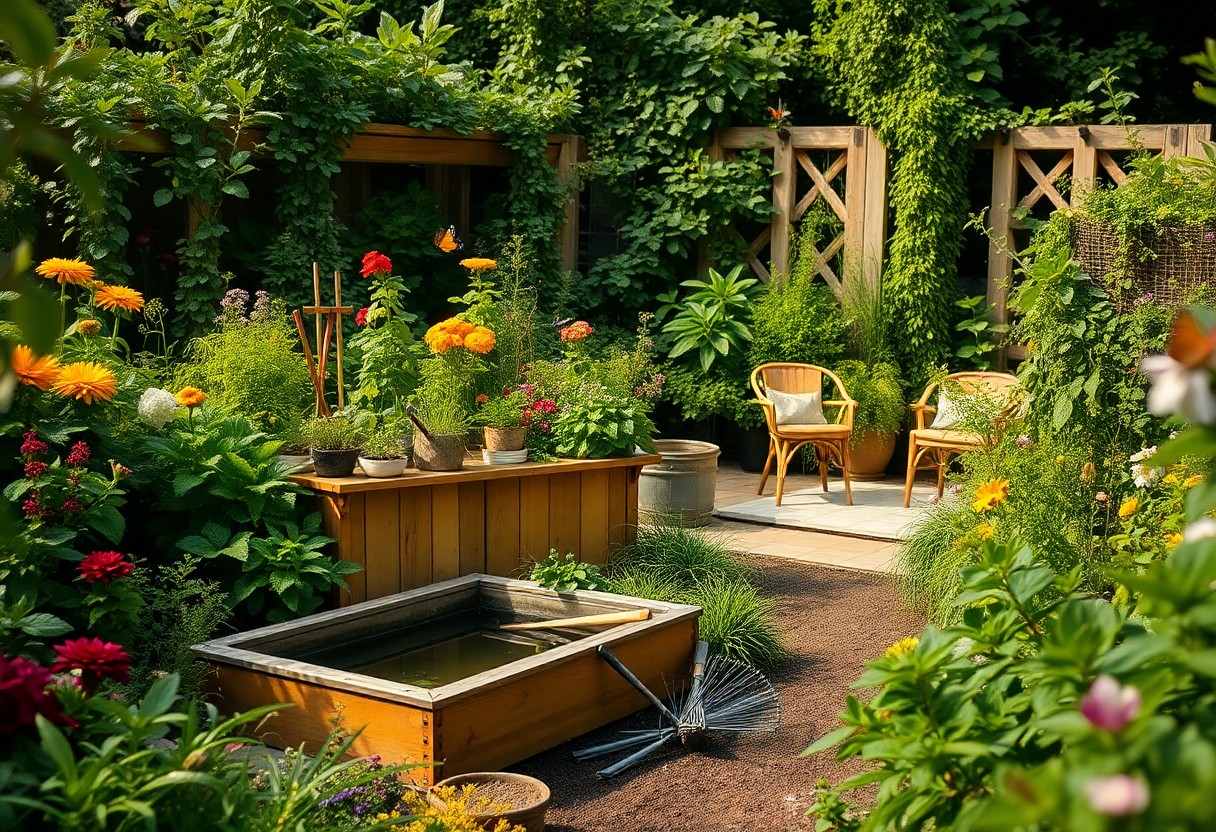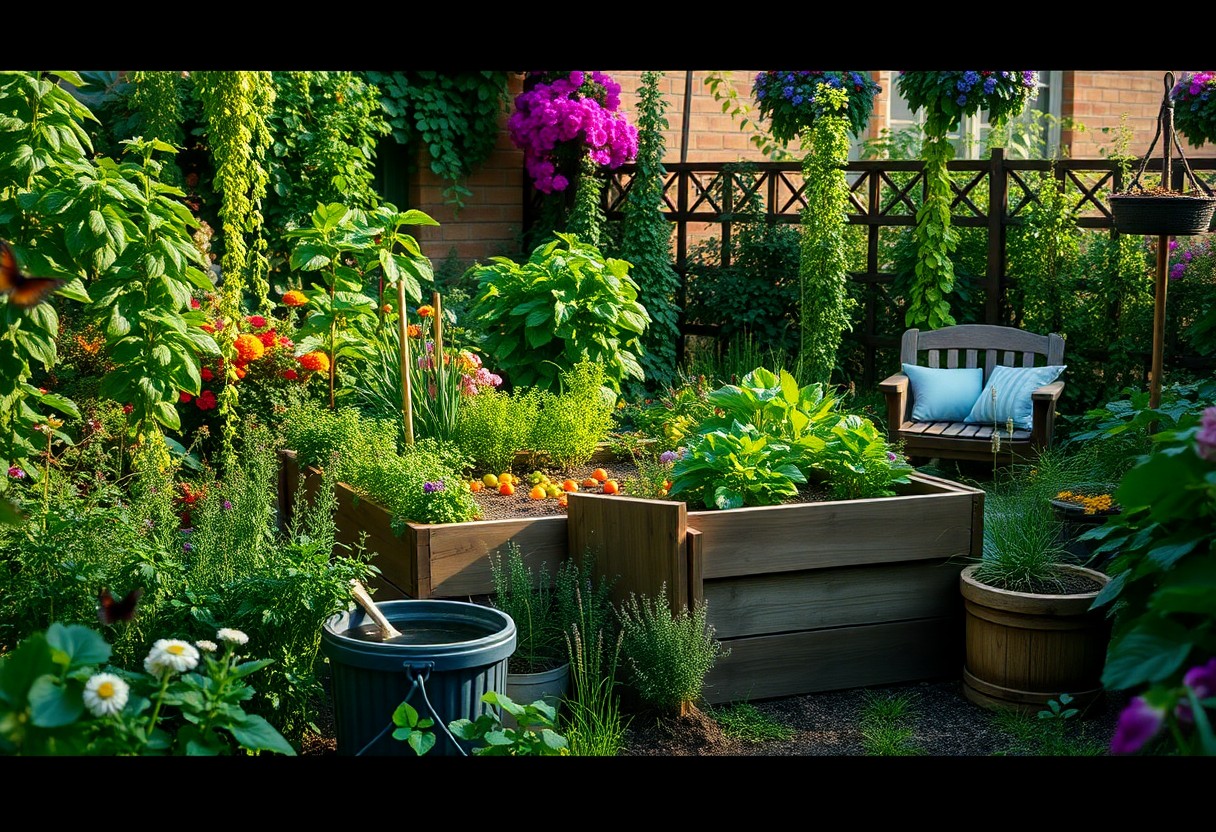Most of us yearn for a peaceful retreat where we can unwind and nourish our wellness, and what better way to create that than through eco-friendly gardening? I’m excited to share my favorite nine steps to transforming your outdoor space into a self-care sanctuary. Not only will you cultivate a vibrant garden, but you’ll also engage in activities that promote mental and physical well-being. Let’s explore how I turned my garden into a green oasis for self-care, and how you can do the same!

Understanding Eco-Friendly Gardening
For anyone looking to create a serene space, eco-friendly gardening offers a harmonious approach that benefits both you and the environment. It emphasizes sustainable practices such as composting, using native plants, and conserving water. If you’re curious about how to make your garden greener, you can check out 10 Ways to be More Sustainable in Your Garden + Yard. By incorporating these strategies, you can cultivate a garden that reflects your values of sustainability while providing a sanctuary for your self-care routine.
Types of Eco-Friendly Gardens
An eco-friendly garden can take many forms, each tailored to different preferences and spaces. Here’s a quick overview of some popular types of eco-gardens that I find inspiring:
| Type | Description |
| Native Plant Garden | Features plants indigenous to your area, promoting biodiversity. |
| Wisdom of Edible Gardens | Focuses on growing your own fruits, vegetables, and herbs. |
| Pollinator Garden | Attracts bees, butterflies, and other pollinators to support ecosystems. |
| Zen Garden | Utilizes minimalism and natural elements to create tranquility. |
| Rain Garden | Designed to capture and filter rainwater, reducing runoff. |
This variety means you can choose an option that aligns with your personal gardening goals and environmental impact. Each type not only enhances your garden’s beauty but also contributes to the well-being of your local ecosystem.
Factors to Consider for Your Garden
To create the perfect eco-friendly garden, there are a few important factors to think about. Understanding your local climate, soil type, and available space will help guide your choices in selecting plants and materials. Here’s a simple list of factors:
- Sunlight exposure – Know how much light your chosen area gets.
- Water sources – Consider irrigation options, including rainwater harvesting.
- Plant compatibility – Choose plants that coexist well together.
- Space constraints – Assess how much room you have for your garden.
- Maintenance requirements – Factor in the time you can dedicate to upkeep.
After determining these factors, you can make informed decisions, ensuring your garden thrives while being eco-friendly. It’s all about creating a space that feels right for you and your lifestyle.
This groundwork sets the stage for a successful gardening journey. You can enhance your garden’s sustainability by considering other aspects such as soil health, pest management, and seasonal changes. Here are some additional details worth exploring:
- Soil quality – Enrich your soil using compost and natural fertilizers.
- Pest control – Utilize eco-friendly methods to manage pests without harmful chemicals.
- Seasonal planting – Understand the best times to plant to ensure optimal growth.
- Waste management – Find ways to recycle organic waste from your garden.
- Community involvement – Connect with local gardening groups for support and advice.
After considering these elements, you’ll be well on your way to establishing a flourishing self-care sanctuary that aligns with your eco-friendly values. Happy gardening!

Step-by-Step Guide to Gardening for Wellness
Assuming you’re ready to transform your outdoor area into a personal sanctuary, I believe that gardening for wellness is a fulfilling step towards self-care. As we cultivate our own gardens, we simultaneously nurture our minds and bodies. For me, it’s about embracing the therapeutic benefits that come from growing my own plants. If you want a deeper investigate the connection between gardening and wellness, I recommend checking out GROWING YOUR OWN WELLNESS GARDEN: A …. This guide will help you harness the power of your garden as a space for healing and relaxation.
Gardening Steps Overview
| Step | Description |
| 1 | Preparing Your Space |
| 2 | Selecting the Right Plants |
| 3 | Caring for Your Plants |
| 4 | Creating a Relaxation Area |
Preparing Your Space
Assuming you have a spot in mind for your garden, the first step is to prepare your space. Start by clearing away any debris or unwanted plants and ensuring the area gets adequate sunlight. I find it helpful to visualize how I want my garden layout to look, considering both functionality and aesthetics. Once the area is cleared, refresh the soil to create a nurturing environment for your new plants. Adding compost or other organic matter can significantly improve soil health.
Selecting the Right Plants
To ensure your garden serves its purpose for wellness, choosing the right plants is vital. I often base my selections on those that not only thrive in my local environment but also bring me joy and serenity. Flowers brings color, herbs can provide culinary satisfaction, and even certain vegetables can enhance my diet. So, consider what you are drawn to and which plants resonate with you personally.
Plus, think about the calming scents of herbs like lavender or rosemary that can enrich your garden experience. These plants not only look beautiful but also have therapeutic properties that add to your overall well-being. I love the idea of walking through my garden and inhaling the soothing fragrances while knowing I’ve nurtured these plants to fruition. By aligning your plant choices with your wellness goals, your garden can truly become a sanctuary for self-care.

Tips for Sustainable Gardening Practices
Clearly, adopting sustainable gardening practices is an important step towards creating a self-care sanctuary in your garden. By focusing on eco-friendly techniques, you not only contribute to the health of the environment but also enhance your own wellbeing. Here are some tips to get you started:
- Opt for organic seeds and plants.
- Use natural fertilizers like compost or worm castings.
- Encourage beneficial insects by planting a variety of flowers.
- Implement crop rotation to maintain soil nutrients.
- Practice mulching to suppress weeds and retain moisture.
After incorporating these practices, you can learn even more about sustainable gardening by exploring the Seven Steps to Sustainable Gardening.
Soil Health & Management
Even though soil might seem like just dirt, it’s the foundation of your garden’s health and your wellness sanctuary. I aim to enrich my soil by adding organic matter, such as compost, which helps retain moisture and nourishes the plants I nurture. Testing my soil pH allows me to take the necessary steps to amend it, ensuring my plants get the nutrients they need to thrive. By avoiding harsh chemicals, I support a healthier ecosystem right beneath my feet.
Water Conservation Techniques
Sustainable gardening also means being mindful of how I use water. Implementing simple measures like rain barrels allows me to collect precious rainwater, which I can use to hydrate my plants. Drip irrigation systems direct water straight to the roots, minimizing wastage and maximizing efficiency. It’s a joyful experience to watch my garden thrive while conserving this vital resource.
Health is a key factor in any garden, and utilizing water conservation techniques not only supports the environment but also eases the stress of maintaining your garden. By adopting practices such as mulching or using drought-resistant plants, you can create a more resilient garden that requires less frequent watering. This not only saves you time but keeps your plants flourishing, ultimately contributing to a serene space where you can unwind and recharge.
The Benefits of Growing Your Own Sanctuary
After embracing the idea of creating an eco-friendly garden, I found that the personal benefits of growing my own sanctuary were truly transformative. Not only does gardening allow me to connect with nature, but it also promotes physical and mental well-being. The mere act of planting seeds and nurturing them into flourishing plants can be a form of therapy that serves to relieve stress and foster a sense of accomplishment. I love how my self-care sanctuary becomes a space where I can unwind, reflect, and experience the simple joys of life, all while contributing to a more sustainable environment.
Additionally, having a personal garden means I can grow my own fresh produce and herbs, making it easier to maintain a healthier diet. When I step outside to tend to my plants, I am reminded of the beauty of life and the importance of nourishing both my body and soul. Plus, sharing homegrown fruits and vegetables with friends and family feels rewarding, creating a ripple effect of wellness and connection in my community.
Pros of Eco-Friendly Gardening
Some of the rewards I’ve experienced with eco-friendly gardening include the exhilarating sense of fulfillment that comes with being self-sufficient. Knowing that I can grow my own food, free from harmful chemicals, is empowering and adds a special touch to my meals. Plus, by adopting sustainable practices, I am doing my part to protect the environment, encouraging biodiversity, and conserving resources. This endeavor can also be a fun, educational experience; as I cultivate my garden, I learn about different plants, insects, and the surrounding ecosystem, enriching my knowledge and appreciation of nature.
Moreover, eco-friendly gardening often leads to long-term financial savings. By growing my own produce, I reduce the need for store-bought vegetables, which can be quite pricey. Additionally, I can utilize composting and other organic methods that cut down on the need for synthetic fertilizers and pesticides, saving money while nurturing the soil. The result is a thriving garden that provides healthier food options at a fraction of the cost.
Cons to Keep in Mind
Clearly, while there are numerous advantages, there are also some challenges to consider when begining on an eco-friendly gardening journey. For instance, the time and effort required to maintain a garden can be daunting, especially if you have a busy schedule. It’s important to understand that gardening is not a one-time commitment; it requires consistent care and attention. This can sometimes lead to feelings of frustration if things don’t go as planned, like dealing with pests or unpredictable weather conditions.
A key point to consider is that growing a sanctuary can involve a learning curve. Some plants might not thrive as you expect, which can be disheartening after investing time and resources. Additionally, you may encounter local pests or diseases that challenge your gardening efforts. However, with practice and persistence, I’ve found these hurdles to be valuable learning experiences. In overcoming them, my gardening skills have improved, and each season brings new opportunities for growth—both in the garden and in myself.
Creating a Relaxation Zone in Your Garden
All of us crave a little piece of serenity in our lives, and what better way to cultivate that than by creating a relaxation zone in your garden? This special spot will be your go-to sanctuary, designed for unwinding and connecting with nature. Imagine soft seating, the sound of rustling leaves, and the gentle aroma of blooming flowers – it’s the perfect environment to escape the daily grind and recharge your spirit. This garden space can be tailored to your personal preferences, incorporating elements that bring you joy and tranquility.
Designing Your Self-Care Space
Clearly, the design of your relaxation zone matters. I recommend starting with a comfortable seating area, perhaps a bench or a cozy hammock, under the shade of your favorite tree. Surrounding your seating with lush plants to create a sense of enclosure can enhance feelings of privacy and calm. I often find that adding beautiful outdoor cushions or blankets makes the space even more inviting. You might also want to consider gentle lighting options, like string lights or solar lanterns, for those magical evenings spent outdoors.
Incorporating Relaxation Techniques
Relaxation in your garden can be achieved in numerous ways! I encourage you to think about activities that bring you peace, whether it’s meditative gardening, reading a book, or enjoying a cup of herbal tea. You can also explore techniques such as yoga or tai chi, where the sounds of nature become your backdrop. Finding what helps calm your mind and soul is key to transforming this garden into your personal oasis.
Your relaxation techniques can truly transform your space. I love to incorporate soft meditation music or calming nature sounds to enhance the ambiance. Additionally, taking the time to breathe deeply while engaging with the plants serves as both a grounding and uplifting practice. As you nourish your garden, you’ll also find yourself cultivating a deeper sense of wellness and connection to your surroundings.
Share Your Eco-Friendly Garden Journey
Your eco-friendly garden journey is not just about nurturing plants; it’s also about nurturing connections. By sharing your experience with others, you create a ripple effect that encourages sustainable practices in your community. I’ve found that engaging with fellow eco-conscious gardeners allows us to exchange tips, support one another, and deepen our collective understanding of environmentally-friendly gardening. Whether it’s through local gardening clubs, community workshops, or social media, sharing stories and insights can foster a sense of belonging and inspiration that fuels our eco-friendly paths.
Connecting with the Community
EcoFriendly gardening is a fantastic avenue to connect with like-minded individuals who share your passion for the planet. I love participating in local gardening events, where I can meet fellow enthusiasts eager to swap seeds, share their experiences, and learn from one another. Joining community gardens not only enhances the biodiversity of our neighborhoods but also invites collaboration and enriches our gardening knowledge. Together, we can grow our appreciation for sustainable practices while cultivating friendships that blossom just like our gardens.
Educating Others
Garden journeys often come with invaluable lessons, and I wholeheartedly believe in passing on that knowledge to others. I’ve found that by sharing what I’ve learned through my eco-friendly gardening attempts, I can inspire someone else to launch on their own green adventure. It’s heartwarming to witness others find joy and wellness in growing their own plants, while also promoting a healthier environment. Educating others about sustainable gardening practices can turn personal achievements into community victories.
Educating friends and family about the benefits of eco-friendly gardening can be incredibly rewarding. Whether it’s hosting a small workshop in my backyard or simply sharing insights during a casual conversation, I’ve seen how contagious enthusiasm can be. It’s wonderful to watch others become curious about native plants, composting, or organic pest control methods, all of which can lead to healthier gardens and ultimately, healthier communities. By encouraging dialogue and sharing resources, I can help create a wave of eco-consciousness that leads to lasting environmental change.
To wrap up
From above, it’s clear that begining on the journey of creating my own eco-friendly garden is not just about growing plants, but also about nurturing my well-being and fostering a deeper connection with nature. By incorporating these nine steps, I can transform my outdoor space into a self-care sanctuary that promotes relaxation, mindfulness, and sustainable living. Each tip encourages me to be more aware of my surroundings and the impact of my choices on the environment while reaping the physical and mental health benefits that come with gardening.
As I cultivate my garden, I find that it’s more than just a hobby; it’s a rewarding practice that enriches my daily life. I invite you to take these steps and personalize them to fit your unique lifestyle and preferences. By doing so, you’ll not only enhance your own wellness but also contribute positively to the planet. Let’s grow together and embrace the healing power of nature in our gardens!

